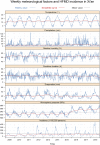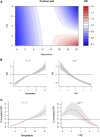Seasonal Distribution and Meteorological Factors Associated with Hand, Foot, and Mouth Disease among Children in Xi'an, Northwestern China
- PMID: 32157992
- PMCID: PMC7253124
- DOI: 10.4269/ajtmh.19-0916
Seasonal Distribution and Meteorological Factors Associated with Hand, Foot, and Mouth Disease among Children in Xi'an, Northwestern China
Abstract
Hand, foot, and mouth disease (HFMD) is a common infectious disease in the Asia-Pacific region that primarily affects children younger than 5 years. Previous studies have confirmed that the seasonal transmission of this disease is strongly related to meteorological factors, but the results are not consistent. In addition, the associations between weather conditions and HFMD in northwestern China have not been investigated. Therefore, we aimed to examine this issue in Xi'an, the largest city of northwestern China that has been suffering from serious HFMD epidemics. In the current study, data for HFMD and six meteorological factors were collected from 2009 to 2018. Using cross-correlation analysis, the Granger causality test, and the distributed lag nonlinear model, we estimated the quantitative relationships and exposure-lag-response effects between weekly meteorological factors and HFMD incidence among children. We found that the seasonal distribution of HFMD in Xi'an has two peaks each year and is significantly impacted by the weekly temperature, precipitation, and evaporation over an 8-week period. Higher values of temperature and evaporation had positive associations with disease transmission, whereas the association between precipitation and HFMD showed an inverted-U shape. The maximum relative risks (RRs) of HFMD for the weekly mean temperature (approximately 31.1°C), weekly cumulative evaporation (57.9 mm), and weekly cumulative precipitation (30.0 mm) were 1.56 (95% CI: 1.35-1.81), 1.40 (95% CI: 1.05-1.88), and 1.16 (95% CI: 1.11-1.70), respectively. The identified risk determinants and lag effects could provide important information for early interventions to reduce the local disease burden.
Conflict of interest statement
Disclaimer: The funders had no role in the study design, data collection, data analysis, data interpretation, or writing of the report.
Disclosure: The corresponding authors had full access to all of the data in this study and had final responsibility for the decision to submit for publication. The authors declare that the research was conducted in the absence of any commercial or financial relationships that could be construed as a potential conflict of interest.
Figures






Similar articles
-
Association of Short-Term Exposure to Meteorological Factors and Risk of Hand, Foot, and Mouth Disease: A Systematic Review and Meta-Analysis.Int J Environ Res Public Health. 2020 Oct 30;17(21):8017. doi: 10.3390/ijerph17218017. Int J Environ Res Public Health. 2020. PMID: 33143315 Free PMC article.
-
The impact of anti-COVID-19 nonpharmaceutical interventions on hand, foot, and mouth disease-A spatiotemporal perspective in Xi'an, northwestern China.J Med Virol. 2022 Jul;94(7):3121-3132. doi: 10.1002/jmv.27715. Epub 2022 Mar 22. J Med Virol. 2022. PMID: 35277880 Free PMC article.
-
Seasonal modeling of hand, foot, and mouth disease as a function of meteorological variations in Chongqing, China.Int J Biometeorol. 2017 Aug;61(8):1411-1419. doi: 10.1007/s00484-017-1318-0. Epub 2017 Feb 10. Int J Biometeorol. 2017. PMID: 28188360
-
Short-term effects of extreme meteorological factors on childhood hand, foot, and mouth disease reinfection in Hefei, China: A distributed lag non-linear analysis.Sci Total Environ. 2019 Feb 25;653:839-848. doi: 10.1016/j.scitotenv.2018.10.349. Epub 2018 Oct 28. Sci Total Environ. 2019. PMID: 30759610
-
Weather effects on hand, foot, and mouth disease at individual level: a case-crossover study.BMC Infect Dis. 2019 Dec 3;19(1):1029. doi: 10.1186/s12879-019-4645-4. BMC Infect Dis. 2019. PMID: 31796004 Free PMC article.
Cited by
-
Association of Short-Term Exposure to Meteorological Factors and Risk of Hand, Foot, and Mouth Disease: A Systematic Review and Meta-Analysis.Int J Environ Res Public Health. 2020 Oct 30;17(21):8017. doi: 10.3390/ijerph17218017. Int J Environ Res Public Health. 2020. PMID: 33143315 Free PMC article.
-
The impact of anti-COVID-19 nonpharmaceutical interventions on hand, foot, and mouth disease-A spatiotemporal perspective in Xi'an, northwestern China.J Med Virol. 2022 Jul;94(7):3121-3132. doi: 10.1002/jmv.27715. Epub 2022 Mar 22. J Med Virol. 2022. PMID: 35277880 Free PMC article.
-
Enterovirus A71 priorities, challenges, and future opportunities in humoral immunity and vaccine development.NPJ Vaccines. 2025 Aug 15;10(1):194. doi: 10.1038/s41541-025-01184-z. NPJ Vaccines. 2025. PMID: 40817335 Free PMC article. Review.
-
The non-stationary and spatially varying associations between hand, foot and mouth disease and multiple environmental factors: A Bayesian spatiotemporal mapping model study.Infect Dis Model. 2024 Feb 10;9(2):373-386. doi: 10.1016/j.idm.2024.02.005. eCollection 2024 Jun. Infect Dis Model. 2024. PMID: 38385017 Free PMC article.
-
Non-linear association between daily mean temperature and children's hand foot and mouth disease in Chongqing, China.Sci Rep. 2023 Nov 21;13(1):20355. doi: 10.1038/s41598-023-47858-3. Sci Rep. 2023. PMID: 37990138 Free PMC article.
References
-
- Huang MC, Wang SM, Hsu YW, Lin HC, Chi CY, Liu CC, 2006. Long-term cognitive and motor deficits after enterovirus 71 brainstem encephalitis in children. Pediatrics 118: 1785–1788. - PubMed
-
- Chang LY, Huang LM, Gau SS, Wu YY, Hsia SH, Fan TY, Lin KL, Huang YC, Lu CY, Lin TY, 2007. Neurodevelopment and cognition in children after enterovirus 71 infection. N Engl J Med 356: 1226–1234. - PubMed
Publication types
MeSH terms
Substances
LinkOut - more resources
Full Text Sources

